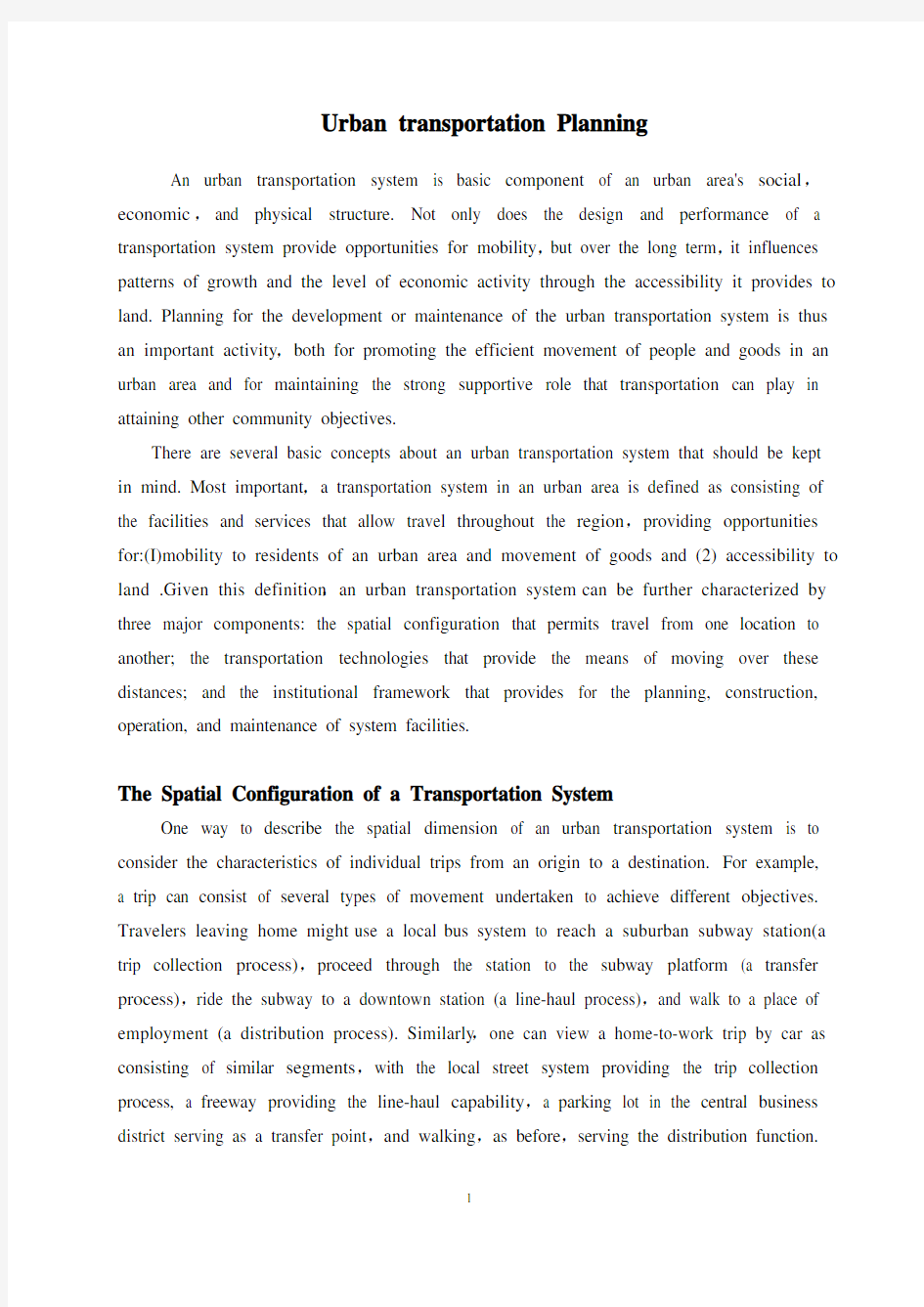
城市交通规划-毕业论文外文翻译
- 格式:docx
- 大小:46.07 KB
- 文档页数:17


Urban transportation Planning
An urban transportation system is basic component of an urban area's social,economic,and physical structure. Not only does the design and performance of a transportation system provide opportunities for mobility,but over the long term,it influences patterns of growth and the level of economic activity through the accessibility it provides to land. Planning for the development or maintenance of the urban transportation system is thus an important activity,both for promoting the efficient movement of people and goods in an urban area and for maintaining the strong supportive role that transportation can play in attaining other community objectives.
There are several basic concepts about an urban transportation system that should be kept in mind. Most important,a transportation system in an urban area is defined as consisting of the facilities and services that allow travel throughout the region,providing opportunities for:(I)mobility to residents of an urban area and movement of goods and (2) accessibility to land .Given this definition,an urban transportation system can be further characterized by three major components: the spatial configuration that permits travel from one location to another; the transportation technologies that provide the means of moving over these distances; and the institutional framework that provides for the planning, construction, operation, and maintenance of system facilities.
The Spatial Configuration of a Transportation System
One way to describe the spatial dimension of an urban transportation system is to consider the characteristics of individual trips from an origin to a destination. For example, a trip can consist of several types of movement undertaken to achieve different objectives. Travelers leaving home might use a local bus system to reach a suburban subway station(a trip collection process),proceed through the station to the subway platform (a transfer process),ride the subway to a downtown station (a line-haul process),and walk to a place of employment (a distribution process). Similarly,one can view a home-to-work trip by car as consisting of similar segments,with the local street system providing the trip collection process, a freeway providing the line-haul capability,a parking lot in the central business district serving as a transfer point,and walking,as before,serving the distribution function.
The facilities and services that provide these opportunities for travel,when interconnected to permit movement from one location to another,form a network. Thus,another way of representing the spatial dimension of an urban transportation system is as a set of road and transit networks. Even in the smallest urban areas,where mass transit is not available,the local street network provides the basic spatial characteristic of the transportation system.
The transportation system of a city can influence the way in which the city's social and economic structure, often called the urban activity system,develops. At the same time,changes in this structure can affect the ability of the transportation system to provide mobility and accessibility. Thus , the transportation system is closely related to the urban activity system and; historically, has been an important determinant of urban form.
Because of the relation between transportation and urban activities,many of the methods used by transportation planners depend on estimates of trips generated by specific land uses. The relation also suggests that the options available to public officials dealing with transportation problems should include not only those related directly to the transportation system, but also actions such as zoning that affect the distribution of land use, and thus influence the performance of the transportation system.
The foregoing considerations point to two important principles for transportation planning: The transportation system should be
Considered as an integral part of the social and economic system in an urban area.
Viewed as a set of interconnected facilities and services designed to provide opportunities for travel from one location to another.
The Technology of Urban Transportation
The technology of urban transportation is closely related to the spatial configuration of the transportation system in that the design transportation networks reflects the speed, operating , and cost characteristics of the vehicle or mode of transportation being used. Technology includes the means of propulsion, type of support,means of guidance,and control technique.
The development and widespread use of electric streetcars in urban areas during the late nineteenth century was a technological innovation that initiated the transformation of most